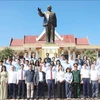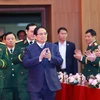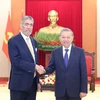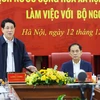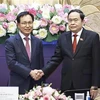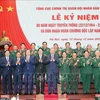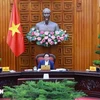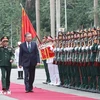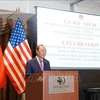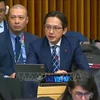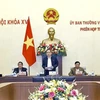Experts have predicted that China will continue to take larger steps after blatantly anchoring the Haiyang Shiyou-981 oil rig in Vietnam’s exclusive economic zone and continental shelf, the VietnamNet Bridge reported on June 10.
China’s deployment of the rig is a step in the realisation of its ambitions to control the East Sea. What will happen after the Haiyang Shiyou-981 oil rig? Prof. Dr. Tran Nam Tien, Deputy Director of the East Sea Research Centre of the Ho Chi Minh City University of Social Sciences and Humanities, and Le Hong Hiep, PhD research student at the University of New South Wales, Australia, spoke with the Ho Chi Minh City Law Newspaper about China’s future plans.
*What shows that the Haiyang Shiyou-981 oil rig is a carefully arranged step by China?
Le Hong Diep: Firstly, China has implemented administrative measures such as strengthening its marine management agencies, establishing the so-called Sansha city, and issuing a fishing ban on the East Sea.
Secondly, China has been building its naval and air forces through modernisation programmes. Currently, the Chinese defence budget is the largest in Asia, beyond the budget of all 10 Southeast Asian countries.
In addition, China has invested largely in semi-armed law enforcement forces such as maritime surveillance and fisheries administration, and others.
Thirdly, China has invested in economic instruments to strengthen its claims in the field. Besides the oil rig, China has enhanced the capability of its offshore fishing fleet, with the fish processing vessel Hainan Baosha 001, with 32,000 tonnes of payload, as a typical example.
Fourthly, China has applied combined political - diplomatic measures, including the official announcement of the U-shaped line at the United Nations in 2009, delaying the signature of a Code of Conduct in the East Sea (COC), and dividing the Association of Southeast Asian Nations (ASEAN) on the issue of East Sea, among others.
Finally, the clearest manifestation in recent time is that China has stepped up aggressive activities in the field to realise its plans, from cutting the cable of the seismic survey vessel of Vietnam to occupying the Scarborough Shoal of the Philippines, and surrounding Co May Shoal (Second Thomas Shoal), to preparing to build a runway on Gac Ma Reef (Johnson Reef), and now anchoring the Haiyang Shiyou-981 oil rig in Vietnam’s waters.
*What does China really want in the East Sea?
Prof. Dr. Tran Nam Tien: The recent actions of China in the East Sea show that Chinese leaders mainly see the East Sea from the perspective of geopolitical and geostrategic strategy. China's real ambition does not stop in the East Sea, but beyond, their vision is the ambitious "string of pearls" strategy, connecting the East Sea with the Indian Ocean.
The "string of pearls" strategy was created recently to solve the strategic priorities of China: ensuring the safety of tankers carrying oil and gas from the Persian Gulf.
*What will China do after the Haiyang Shiyou-981 oil rig?
Prof. Dr. Tran Nam Tien: Following the blatant deployment of the oil rig, China will continue to take bigger steps.
It is China’s current powerful development, dependence on the supply of resources and energy from abroad, particularly oil and natural gas, that is playing an important role in forming China’s development policy and strategy.
In addition, the building of the "string of pearls" strategy aims to ensure the ability to control the Indian Ocean, if it ever clashed with one of its strongest potential opponents, namely India.
*What will China do in response to the reaction of Vietnam and the international community?
Le Hong Hiep: To perform its hegemonic ambitions in the sea, in particular in the Haiyang Shiyou-981 oil rig case, China will not give up easily. At least they will keep the drilling rig until August 15 as they stated.
Over the long term, considering factors of internal resources and strategies, to finish its hegemonic ambitions on the sea, on the one hand, the Chinese will continue to strengthen its "hard power," including naval and air force capacity and paramilitary forces. On the other hand, it will seek to divide public opinion, using diplomatic-economic measures to buy off support and try to isolate Vietnam. There is a certainty that China will be increasingly aggressive and decisive in creating a “fait accompli” to squeeze Vietnam.
*What risks will China face in its expansion strategy?
Le Hong Hiep: China's biggest risk is that their actions will destabilise regional strategic environment, leading to fears of neighbouring countries and the intervention of external powers, especially the United States.
If China continues to pursue its marine ambitions in an aggressive way and defy international law as it does at present, it is likely that many regional countries will work together to cope with China’s pressure, and at the same time the US-China strategic competition will have good reasons to rise.
In the long term, the possibility of a new Cold War between China and the US and its allies can happen. If so, China will face difficulty, not only in the military and strategy, but also in socio-economic development. That could be a noose that they could get caught in.-VNA
China’s deployment of the rig is a step in the realisation of its ambitions to control the East Sea. What will happen after the Haiyang Shiyou-981 oil rig? Prof. Dr. Tran Nam Tien, Deputy Director of the East Sea Research Centre of the Ho Chi Minh City University of Social Sciences and Humanities, and Le Hong Hiep, PhD research student at the University of New South Wales, Australia, spoke with the Ho Chi Minh City Law Newspaper about China’s future plans.
*What shows that the Haiyang Shiyou-981 oil rig is a carefully arranged step by China?
Le Hong Diep: Firstly, China has implemented administrative measures such as strengthening its marine management agencies, establishing the so-called Sansha city, and issuing a fishing ban on the East Sea.
Secondly, China has been building its naval and air forces through modernisation programmes. Currently, the Chinese defence budget is the largest in Asia, beyond the budget of all 10 Southeast Asian countries.
In addition, China has invested largely in semi-armed law enforcement forces such as maritime surveillance and fisheries administration, and others.
Thirdly, China has invested in economic instruments to strengthen its claims in the field. Besides the oil rig, China has enhanced the capability of its offshore fishing fleet, with the fish processing vessel Hainan Baosha 001, with 32,000 tonnes of payload, as a typical example.
Fourthly, China has applied combined political - diplomatic measures, including the official announcement of the U-shaped line at the United Nations in 2009, delaying the signature of a Code of Conduct in the East Sea (COC), and dividing the Association of Southeast Asian Nations (ASEAN) on the issue of East Sea, among others.
Finally, the clearest manifestation in recent time is that China has stepped up aggressive activities in the field to realise its plans, from cutting the cable of the seismic survey vessel of Vietnam to occupying the Scarborough Shoal of the Philippines, and surrounding Co May Shoal (Second Thomas Shoal), to preparing to build a runway on Gac Ma Reef (Johnson Reef), and now anchoring the Haiyang Shiyou-981 oil rig in Vietnam’s waters.
*What does China really want in the East Sea?
Prof. Dr. Tran Nam Tien: The recent actions of China in the East Sea show that Chinese leaders mainly see the East Sea from the perspective of geopolitical and geostrategic strategy. China's real ambition does not stop in the East Sea, but beyond, their vision is the ambitious "string of pearls" strategy, connecting the East Sea with the Indian Ocean.
The "string of pearls" strategy was created recently to solve the strategic priorities of China: ensuring the safety of tankers carrying oil and gas from the Persian Gulf.
*What will China do after the Haiyang Shiyou-981 oil rig?
Prof. Dr. Tran Nam Tien: Following the blatant deployment of the oil rig, China will continue to take bigger steps.
It is China’s current powerful development, dependence on the supply of resources and energy from abroad, particularly oil and natural gas, that is playing an important role in forming China’s development policy and strategy.
In addition, the building of the "string of pearls" strategy aims to ensure the ability to control the Indian Ocean, if it ever clashed with one of its strongest potential opponents, namely India.
*What will China do in response to the reaction of Vietnam and the international community?
Le Hong Hiep: To perform its hegemonic ambitions in the sea, in particular in the Haiyang Shiyou-981 oil rig case, China will not give up easily. At least they will keep the drilling rig until August 15 as they stated.
Over the long term, considering factors of internal resources and strategies, to finish its hegemonic ambitions on the sea, on the one hand, the Chinese will continue to strengthen its "hard power," including naval and air force capacity and paramilitary forces. On the other hand, it will seek to divide public opinion, using diplomatic-economic measures to buy off support and try to isolate Vietnam. There is a certainty that China will be increasingly aggressive and decisive in creating a “fait accompli” to squeeze Vietnam.
*What risks will China face in its expansion strategy?
Le Hong Hiep: China's biggest risk is that their actions will destabilise regional strategic environment, leading to fears of neighbouring countries and the intervention of external powers, especially the United States.
If China continues to pursue its marine ambitions in an aggressive way and defy international law as it does at present, it is likely that many regional countries will work together to cope with China’s pressure, and at the same time the US-China strategic competition will have good reasons to rise.
In the long term, the possibility of a new Cold War between China and the US and its allies can happen. If so, China will face difficulty, not only in the military and strategy, but also in socio-economic development. That could be a noose that they could get caught in.-VNA
